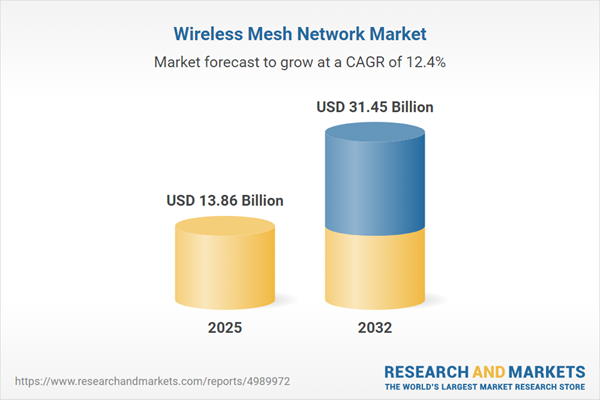Speak directly to the analyst to clarify any post sales queries you may have.
Wireless mesh networks have become foundational for enterprises seeking flexible, resilient digital infrastructure. These advanced networks allow senior leaders to implement secure, adaptive connectivity aligned with organizational transformation priorities.
Market Snapshot: Wireless Mesh Network Market Growth
Strong growth is forecast for the wireless mesh network market between 2024 and 2025, propelled by increasing enterprise adoption and pressing needs for adaptive digital infrastructure. Accelerated digitization across manufacturing, commercial services, and sectors with mission-driven demands is spurring deeper market penetration. Organizations are prioritizing solutions that secure business continuity and streamline network expansion. Unlike traditional networks, wireless mesh systems remove single points of failure, enabling self-healing, distributed coverage. These features are particularly valued in sectors where continuous operations and distributed connectivity are crucial, further driving the market’s evolution.
Scope & Segmentation
- Component: The core of wireless mesh networks includes gateways, nodes, routers, switches, and specialized management and security software. Professional services are essential for deployment and performance optimization in complex settings.
- Type: Enterprise deployment options include client, hybrid, and infrastructure mesh architectures. Each supports customizable scalability, built-in security, and regulatory compliance, responding to dynamic site and operational requirements.
- Technology: Key platforms such as Wi-Fi, ZigBee, LoRaWAN, and Bluetooth mesh are selected for tasks requiring specific coverage, power efficiency, or data throughput. These technologies support diverse use cases in industrial automation, large public venues, and smart retail environments, offering flexibility across operational scenarios.
- Application: Wireless mesh is used in settings ranging from manufacturing, mining, oil and gas, and defense to public safety and challenging residential environments. Organizations benefit from reliable coverage where conventional network approaches are impractical, ensuring adaptable and persistent connectivity.
- End User: Sectors including education, public administration, utilities, healthcare, energy, and retail implement wireless mesh for their unique regulatory, scalability, and continuity demands, addressing sector-specific operational and risk requirements.
- Geographic Coverage: Adoption rates differ by region, influenced by local infrastructure and regulations. Notable market traction occurs in the Americas—particularly the United States, Canada, Mexico, Brazil, Argentina, Chile, Colombia, and Peru—as well as Europe, the Middle East, Africa, and throughout Asia-Pacific, especially in China, India, Japan, Southeast Asia, and Oceania. Regional investment and digital readiness shape deployment strategies.
- Companies Profiled: Leading solution providers such as Cisco Systems, Hewlett Packard Enterprise, Ubiquiti, CommScope, Huawei, Juniper Networks, Fortinet, Extreme Networks, Cambium Networks, and NETGEAR offer targeted offerings that keep pace with evolving enterprise requirements and network complexity.
Key Takeaways: Strategic Insights for Enterprise Networking
- Decentralized mesh architectures give organizations greater agility, supporting adaptable operations and maintaining steady network performance as locations and demands shift.
- Streamlined onboarding and deployment reduce time-to-value, enabling rapid scaling of network capabilities to support digital initiatives and dynamic workforce needs.
- Mesh solutions extend secure, reliable coverage into remote or infrastructure-limited areas, facilitating uninterrupted operations in environments where traditional networks falter.
- For mission-driven sectors like automated manufacturing, logistics, and emergency services, mesh frameworks offer self-healing and failover functions to sustain operational continuity and minimize downtime.
- Managed mesh platforms ease compliance, supporting organizations in meeting evolving regulations and swiftly adapting IT priorities through centralized administration tools.
- Centralized network management enhances scalability, providing leaders with the oversight needed to align connectivity infrastructure with ongoing digital transformation objectives.
Strategic Tariff Impact
Recent changes in United States tariffs affecting wireless mesh network components have prompted enterprises to review procurement strategies. In response, top vendors are strengthening local partnerships and regional distribution channels, supporting businesses in controlling costs and maintaining resilient connectivity. Flexible procurement options and service bundles are growing in popularity, allowing organizations to manage budget pressures and uphold operational continuity as regulations shift.
Methodology & Data Sources
This analysis leverages quantitative data from primary research and qualitative insights from executive interviews and specialized market experts. All findings undergo thorough cross-verification to ensure data integrity, assisting decision-makers as they plan network modernization investments in unpredictable business environments.
Wireless Mesh Network Market: Why This Report Matters
- Enables leadership teams to steer digital acceleration and meet Internet of Things demands by deploying secure, scalable enterprise networks.
- Provides actionable recommendations for investment in wireless mesh solutions, supporting compliance and risk management across diverse sectors.
- Clarifies evolving technology and regulatory developments so organizations can craft resilient network strategies for future growth.
Conclusion
Wireless mesh networks empower enterprises to build adaptive, resilient platforms for ongoing digital innovation. This report equips leaders to deploy robust connectivity strategies for improved performance and sustained organizational advancement.
Additional Product Information:
- Purchase of this report includes 1 year online access with quarterly updates.
- This report can be updated on request. Please contact our Customer Experience team using the Ask a Question widget on our website.
Table of Contents
3. Executive Summary
4. Market Overview
7. Cumulative Impact of Artificial Intelligence 2025
List of Figures
Companies Mentioned
The companies profiled in this Wireless Mesh Network market report include:- Cisco Systems, Inc.
- Hewlett Packard Enterprise Company
- Ubiquiti Inc.
- CommScope, Inc.
- Huawei Technologies Co., Ltd.
- Juniper Networks, Inc.
- Fortinet, Inc.
- Extreme Networks, Inc.
- Cambium Networks, Ltd.
- NETGEAR, Inc.
Table Information
| Report Attribute | Details |
|---|---|
| No. of Pages | 198 |
| Published | November 2025 |
| Forecast Period | 2025 - 2032 |
| Estimated Market Value ( USD | $ 13.86 Billion |
| Forecasted Market Value ( USD | $ 31.45 Billion |
| Compound Annual Growth Rate | 12.3% |
| Regions Covered | Global |
| No. of Companies Mentioned | 11 |









